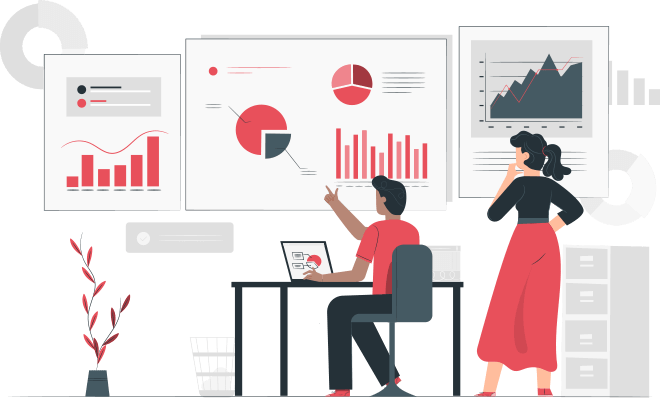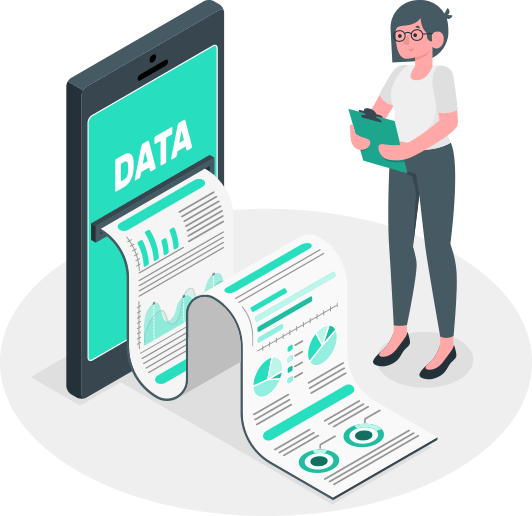

Quantitative Business Analysis Explained with Examples
Editorial Team

What is Quantitative Analysis?
Business analysis is a research field that can assist us in identifying problems and developing convincing solutions to them. A business analyst can help an organization develop effective and efficient solutions. However, creating leads to address the challenges is difficult, but it is doable by the business analyst alone. After all, business analysis is a collaborative effort, and using effective solutions can help a firm grow and flourish. Practical answers to business-related difficulties are critical to every company’s success.
Techniques, methods, software, strategic planning, policy formulation, organizational structure reform, and other enhancements to the firm or project are all part of the business analysis process. The basic aim of business analysis is to discover the best solution for a specific situation and business analysis provides us with insights into how to create a specific project. Applying or adopting them will provide us with a competitive advantage. Any company that wants to stay competitive in the market might benefit from business analysis.
Techniques of Quantitative Analysis
A quantitative analyst’s primary task is to express a given hypothetical situation in terms of numerical value. Quantitative analysis is beneficial for making forecasts, assessing financial products, and evaluating performance. Its three methods of data measurement are regression analysis, linear programming, and data mining.
1. Regression Analysis
Statistics professionals, economists, business owners, and other professionals frequently employ regression analysis. It entails applying statistical equations to make predictions or estimate the effects of one variable on another. For example, regression analysis can indicate how interest rates influence consumers’ asset investment decisions. Another application of regression analysis is determining the impact of education and job experience on employees’ annual wages.
Business owners can utilize regression analysis to determine how advertising costs affect their bottom line. Using this strategy, a business owner can decide whether two things have a positive or negative relationship.
2. Linear Programming
Most organizations experience intermittent shortages of resources such as office space, manufacturing equipment, and people. In such cases, corporate managers must design ways to use resources wisely. Linear programming is a quantitative approach that indicates how to arrive at such an optimum solution. It is used to examine how a corporation may maximize earnings while lowering operating expenses given a set of constraints, such as labor.
3. Data Mining
Data mining combines statistical techniques with computer programming expertise. Data mining is becoming well-liked as the variety and number of data sets available expand. Very big data sets are analyzed using data mining techniques to look for hidden patterns or relationships.
Different Types of Business Analysis Methods
Strengths, Weaknesses, Opportunities, and Threats (SWOT) analysis, Political, Economic, Social, Technological, Legal, and Environmental (PESTLE) analysis, HeptalysisTM, the 5 Whys method, and the Six Thinking Hats® method are a few of the business analysis techniques. All businesses should perform business analysis if they want to succeed. Such an analysis reveals the demands and issues of the firm and may also suggest the best solutions for achieving its objectives.
1. SWOT Analysis
The most often used method of company analysis is the SWOT analysis. A company must be aware of its strengths and weaknesses or the areas where it operates best. Examples of strengths would be the best-performing departments or activities. Opportunities and threats are two ways that competitors are categorized in the marketplace to identify areas where the competition is struggling, which presents a business opportunity, as well as areas where the competitor is succeeding, which poses a threat to the company using this method of strategic planning.
A technique for assessing the external environment in which a corporation operates is PESTLE analysis. This kind of analysis aids a company mainly in situating itself in the area. Additionally, it provides commercial solutions for adjusting product prices, modernizing technology infrastructure, and favorably influencing society.
3. Heptalysis
Due to its seven main areas of inquiry, HeptalysisTM is possibly the most in-depth form of business analysis. These include market prospects, goods or services, financial considerations, plans for implementation, human resources, prospective returns on investment, and margin of safety. Especially during the early stages of development, a business analyst can identify the most crucial elements of launching and maintaining a corporation using this method. Because it encompasses all primary business operations, this type of analysis is also essential for developing policies.
4. The 5 Whys Method
The 5 Whys Method is excellent for identifying the root causes of company issues and promoting organizational transformation. It starts by outlining the problems faced by the company, followed by a “why” and a subsequent “why” it is frequently perceived as a straightforward strategy. Despite how simple it may seem, it demands participants to delve deeper and consider the underlying reasons for the issues within the company. The fundamental cause found using the 5 Whys method is typically unexpected and quite precise.
5. Six Thinking Hats
The Six Thinking Hats approach to business analysis is the best for brainstorming sessions that can produce good answers for strategic planning. In this scenario, several organization members are picked and assigned positions or ways of thinking that are color coded. These include black for pessimistic perspectives, yellow for optimistic views, green for creative views, and white for logical or factual thinking. When deciding on manufacturing or marketing solutions, this strategy works incredibly effectively for service- and product-oriented firms.
Advantages of Business Analysis
The process of assessing the needs of an organization and providing realistic solutions to business-related challenges is known as business analysis. It entails developing new strategies or processes to create a suitable plan and applying them to the firm. Business analysis is a vital tool for providing insights and real cost-cutting measures. New marketing methods and commercial difficulties have emerged as a result of technological innovation. Business analysis can help us better grasp what we’re up against, giving us an advantage and a better likelihood of success in the market. Business analysis can help an organization’s market presence, resulting in increased sales and ROI. In the financial market, it is critical to establish a solid foundation and business structure. So, how can we put practical business analysis to use? This is where business analysts come in.
Business analysts are critical members of any organization. They can have a substantial impact on an organization’s budget. Using reasonable business analysis can provide us with the following advantages:
1. Increased Return on Investment(ROI)
The most important goal of any firm in the market today is to have a consistent ROI. Using business analysis can dramatically reduce costs, allowing for greater profit. Implementing efficient techniques and solutions to work-related difficulties can result in significant cost savings. ROI assesses the effectiveness of the solution we implemented and analyzes its investment. Practical solutions are required for any organization to favorably influence the firm.
2. Reduce expenses
Using business analysis can help an organization save money on numerous initiatives or operations. Business analysts can save money by developing and applying cost-effective methodologies, strategies, and approaches. Reduced corporate costs are an important component that can aid a firm’s development and growth. Business analysts and the team can devise creative solutions to recurring challenges that are both affordable and practical.
3. Increased Success Rate
Any organization’s empirical pillar is business analysis. This can increase the project’s success percentage by utilizing effective and cost-effective remedies to any challenges that may develop. A robust team structure and business analyst(s) can also save a project from failure. We can also use business analysis to keep track of projects and make changes more quickly that can assist us in meeting the project’s objectives and aims.
4. Collaboration in an Effective Team
We lose a lot of money and time addressing a single issue, which causes project delays. Using business analysis can be advantageous to both the organization and its employees. It can enhance team collaboration, resulting in speedier project implementation and completion. This can also help to avoid mistakes and lessen the need for rework on a given project. Effective team collaboration allows project completion on time and within budget.
5. Expect Business Issues
Business analysis can provide us with insight that can assist us to envision the challenges that may develop. By developing a viable solution, we can prevent project rework by adopting the best processes and techniques. Problems are unavoidable in the marketing business. It is preferable to be prepared to predict and address future challenges.
6. Sales Increase
Increased sales is an important goal and ambition of any business. We can increase revenue by applying business analysis. How can business analysts develop marketing plans that use an efficient method of acquiring information about the needs and desires of the target audience? Furthermore, low-cost and efficient solutions can reduce costs, resulting in substantial sales.
7. Potential for improvement.
Every company isn’t perfect. Management will face issues from time to time. Using business analysis can show us where we can improve. We all know that owning a business is difficult therefore prospering oneself is essential. This can be very advantageous to both management and employees. This can also help to improve abilities and help the organization grow and thrive. In any particular market, having competent management and staff may build or ruin a corporation in the long run.
Quantitative Analysis Applications In The Business World
Let’s look at an illustration of how quantitative analysis might be used to navigate risky investing markets. One of the main concerns for those who invest in international markets is geopolitical risk. The risk became serious with the COVID-19 epidemic and the global inflationary surge. According to an online poll by Bloomberg, 70% of investors spend too much time researching and maximizing their risk exposure. Here’s where quality assurance technologies like Bloomberg Intelligence’s “Factor Evaluation Model” come into play. It takes into account variables such as valuation, volatility, dividend yield, etc. With the help of this model, investors can look up historical country-level geopolitical patterns and see how they affected the markets. Investors can examine the effects of the presidential election, the financial crisis in Greece, the 2011 earthquake in Japan, etc. A tool like this would assist investors in evaluating many viewpoints, comprehending the markets, and making sensible investments. It additionally improves their profits and helps diversify their portfolio by lowering risk.
How Are The Abilities Of Quantitative Analysis Used In The Workplace?
Quantitative analysis can be used to inform decision-making in all business domains. Data is more easily accessible as businesses develop to become more digitally focused. The amount of data that businesses access now is more substantial than ever before, whether through their website or social media. Businesses have access to a wide range of insights that influence choices across all departments when they use this data efficiently to analyze trends, anticipate future revenue, and plan marketing initiatives. Business leaders frequently have to make judgments in an uncertain environment. They can produce the most accurate estimations thanks to quantitative methodologies, which help to reduce the risks involved. To help business owners understand information better and make the best decisions possible, quantitative models are ideal. Here are a few examples of how companies can employ quantitative analysis:
1 . Project Administration
One area where quantitative analysis is useful is project management. When resources are scarce, quantitative methodologies are used to establish the proper distribution of those resources, as previously stated. Then, based on the availability of specific resources, projects are scheduled. To determine the allocation of resources effectively quantitative methods can be used. Project managers may schedule and plan projects for the best outcomes by identifying the resources needed for specific activities and the resources available at certain stages of a project.
2. Manufacturing Planning
Individuals can use quantitative analysis to make smart decisions about product planning. Consider a situation where a business finds it difficult to predict the size and location of a new production facility. A quantitative analysis can be used to compare various costs, timing, and location proposals. Companies will be better equipped to meet their consumers’ needs while maximizing their revenues with smart product planning and scheduling. Several factors need to be taken into account when planning production volumes. Businesses must consider choices including updating or extending existing facilities, constructing additional manufacturing facilities, or outsourcing production when consumer demand exceeds production capacity. Decisions based on cost, risk, and timing can be made using quantitative analysis techniques to produce the greatest results for the business.
3. Marketing
Every company needs a sound marketing plan. Setting a budget for the marketing division can be challenging if its goals are not defined. Marketers can calculate the necessary budget and allocate media purchases with ease if they use the appropriate quantitative strategy. Data gathered from marketing activities may be used to inform the decisions. Marketers employ quantitative analysis to allocate resources, and marketing teams use campaign data analysis to calculate the return on investment for their projects. They can then utilize this knowledge to change their marketing strategy and estimate future campaign outcomes. To better understand their audience marketing teams frequently mix quantitative methodologies with qualitative analysis through focus groups or open-ended questionnaires. Marketing professionals may design more successful campaigns by having a better grasp of consumer behavior.
Financial reporting is a significant area in which quantitative analysis is used. Analysts strive to minimize expenses, maximize income, and ultimately boost profits while examining balance sheets. Businesses can utilize data analysis to plan, forecast, and carry out activities to meet financial objectives because financial data is frequently given on a monthly, quarterly, and annual basis. Pricing selections are one specific area where quantitative research can significantly impact a company’s profitability. To maximize revenues analysts can predict and assess how consumers will respond to price adjustments. A company’s accounting division also makes extensive use of quantitative analysis. Accounting professionals evaluate an investment’s value using quantitative data and techniques, including the discounted cash flow model. Products can also be judged according to their profitability and production costs.
5. Stock and Purchase
One of the most challenging difficulties companies confront is predicting demand for a good or service. Using quantitative approaches businesses can be advised on how many resources to purchase, how much inventory to have on hand, and how much it will cost to ship and store finished things. For businesses, being able to predict consumer demand is very advantageous. You can ensure you have enough inventory on hand at the appropriate moment to meet demand if you can forecast potential future sales. Businesses can predict the volume of stock they need to buy, the amount of inventory required to meet demand, and how much this will cost to buy, transport, and store by using quantitative analysis to uncover historical trends and growth levels. Being able to pinpoint these expenses helps with budgeting as well
Utilizing mathematical and statistical methods to evaluate a company’s performance is known as quantitative analysis. Before the development of quantitative analysis, many corporate directors relied on their intuition and expertise to make choices. Today business executives can utilize quantitative techniques to forecast trends, choose how to allocate resources, and oversee initiatives. Investment evaluation also uses quantitative methods. Organizations can choose the best assets to invest in and the ideal moment to do so in this fashion. Data mining, linear programming, and regression analysis are a few quantitative analytical techniques.
- Guide to Modernizing Supply Chain Management
- 10 Ways To Grow Your Business Online Using Videos
- What’s The Best Route Planning Software
- What Is Performance Management and How Does It Affect Business Success? We Discuss
most recent

Top 33 Creditors Clerk Interview Questions and Answers 2024

Top 33 Walmart Assistant Manager Interview Questions and Answers 2024

Top 33 Assistant Property Manager Interview Questions and Answers 2024
© 2024 Copyright ProjectPractical.com
What Is Quantitative Business Analysis, and How Can it Help My Business?

Max 7 min read

Click the button to start reading
Every company owner wants to understand how their business is doing. And every potential investor wants to ensure they have as much information as possible about a company before they put their money into an organization. Running a company is a complicated and demanding process, and it’s not always easy to get a clear picture of the situation—especially when you’re in the middle of its affairs. Business analysis techniques provide us with a framework to ask relevant questions and understand just what’s going on within an organization.
In this blog post, we’ll take a closer look at the benefits of quantitative business analysis and the kinds of tools it brings to the table.
Let’s dive right in.

Qualitative vs. quantitative analysis
We can break business analysis into two types—qualitative and quantitative analysis. Both provide valuable insight, and using them together is the best way to evaluate a business successfully. So, before we get into the details of quantitative business analysis (QBA), let’s quickly compare the two approaches.
Qualitative analysis
Qualitative analysis involves examining aspects of the business and its market that cannot be quantified (expressed numerically). For example, we might use qualitative techniques to assess a business’s:
- Core business model — how does the company operate?
- Motivation — what is the company trying to achieve?
- Integrity and values — how does the company measure up ethically?
- Corporate governance — do the people involved live up to the company values?
- Target audience — what are the customers’ goals, aspirations, and fears?
Clearly, these are important factors in any business decision. They are also impossible to quantify. We can assess these aspects in different ways – many of which will be particular to us – but we can’t use them to crunch numbers and reach meaningful conclusions.
Quantitative analysis
Quantitative business analysis means using hard data to assess the health of a business and make predictions about its future. With QBA, we ask questions using specified parameters and variables and use numerical values to express the resulting data.
For example, as an investor assessing a potential investment, you might set minimum acceptable values for the following factors:
- Earnings per share.
- Return on equity.
- Return on capital.
- Free cashflow.
After analyzing the data, you would make a decision based on whether the business in question exceeds your minimum values or not.

What quantitative business analysis is used for
Whether you’re an investor looking to assess the performance of a prospective investment, or a business owner aiming to make your business more efficient or profitable, quantitative business analysis provides you with the tools you need to make decisions. QBA techniques are often used to examine relationships between variables, such as:
- Market share.
We can use QBA to assess most aspects of business performance and help us understand hidden correlations and relationships. Some typical applications are:
- Forecasting.
- Reducing costs and increasing profit.
- Predicting customer behavior.
- Understanding brand penetration.

The role of statistics
Statistics often get a bad rap. You’re probably familiar with the phrase, “There are three kinds of lies: lies, damned lies, and statistics.” Although the origin of the phrase is uncertain (they’re often attributed to Mark Twain, but he attributed 19th-century British prime minister Benjamin Disraeli, and there’s no record of him using the phrase), many of us have taken the words to heart and are somewhat mistrustful of statistics.
While it’s true that statistics without proper context are meaningless and misleadingly presented statistics can be used for dubious purposes, statistical methods are the backbone of quantitative business analysis and give us powerful tools to aid our business decision-making.
Quantitative business analysis techniques
We’re not going to dig too deep into the technical side of QBA here, but it is advisable to get a basic understanding if you’re planning on combining quantitative business analysis and business decisions. There are a dizzying number of quantitative analysis methods that we can use in business analytics, but today we’ll stick to a few of the most commonly used techniques.
Break-even analysis
One of the more straightforward types of QBA, we use a break-even analysis to compare business spending with revenue over a specific time period to determine how much money the company has to bring in to cover its costs.
Regression analysis
We use regression analysis to assess the relationship between two or more variables. If there are two variables, we call it simple regression. Multiple regression involves three or more variables. An example would be identifying a correlation between how much we spend on materials to produce a product and the profit the product generates.
Time series analysis
With time series analysis, also known as trend analysis, we examine historical data to predict future performance. An example would be looking back over sales performance during past Christmases and using that data to make a forecast for the upcoming festive season. This method is best used for short-term forecasting.

How quantitative business analysis helps businesses
By using verifiable, high-quality data to assess business performance and make forecasts, we free ourselves from the biases and emotional reactions that can cloud our judgment. We also find a deeper understanding of the currents and trends that shape the market but aren’t necessarily obvious.
We can use QBA not only to assess business performance, but improve it. By implementing plans based on the result of our analyses, we can see improvements in areas like:
- Cost efficiency.
- Team performance.
- Sales forecasting.
- Brand recognition.
How to implement quantitative business analysis
While you can utilize QBA techniques yourself, unless you’re a statistician or data scientist, it’s going to be a challenge with a steep learning curve. If the business you want to analyze is small, or you only want to answer one or two simple questions, a DIY approach could work. There are plenty of courses available online to help you learn the skills. Beware though, because poorly designed or implemented analysis is at best a waste of time and could cause damage if you make business decisions based on inaccurate data.
For most people, employing a professional is the best way to get reliable, meaningful results. An experienced business analyst will work with you to determine what data you want to gather, the most appropriate methods to collect them, and which techniques should be used for the analysis.
Whichever route you decide to take, the process will go something like this:
- Define the questions — what exactly are you trying to learn about the business? It’s vital to be as precise as possible.
- Determine which analysis technique to use — this will depend on what you’re trying to get out of the analysis.
- Decide how you’re going to collect the data — for example, will you conduct an email campaign? Use a crowd-working platform? Physically ask people questions as they leave a store?
- Implement the data collection methods — get the infrastructure in place and conduct any necessary staff training.
- Gather the data — remember, the data needs to be high quality and relevant.
- Perform the analysis — apply your chosen technique to crunch the numbers.
- Use the findings to take action — once you have your results, do something with them. If you find yourself dismissing or ignoring the results, ask yourself why. Did you ask the wrong questions? Make mistakes with the data? Or are the results telling you something you’re reluctant to admit?

Things to remember
Before jumping into your analysis, make a plan. Lay out exactly what you want to achieve and how you’re going to achieve it. Here are a few things to bear in mind:
- Ask the right questions — it’s crucial to ensure that the data you’re gathering is relevant and usable.
- Use high-quality data — faulty data leads to false conclusions, so gather your data carefully.
- Keep it simple — don’t try to analyze too much at once – you’ll run the risk of confusing the results.
- Context is key — no business exists in a vacuum, so make sure to include competition and the broader market in your analyses.
- Bad analysis is worse than no analysis — if in doubt, hire a professional!
The bottom line
Quantitative business analysis allows us to dig deep into data to understand business performance, identify patterns that might not be immediately obvious, and make reliable forecasts about the future. We can use QBA techniques to inform our business decisions and improve performance within our organizations.
QBA can be used alongside other types of analysis to form a complete picture of a company’s health. Because the methods involved are complex, it’s a good idea to consult a professional business analyst before you get started. Understanding the process is valuable, though, so it’s worth getting to grips with the terms and various techniques involved.
#ezw_tco-2 .ez-toc-title{ font-size: 120%; ; ; } #ezw_tco-2 .ez-toc-widget-container ul.ez-toc-list li.active{ background-color: #ededed; } Table of Contents
Manage your remote team with teamly. get your 100% free account today..

PC and Mac compatible

Teamly is everywhere you need it to be. Desktop download or web browser or IOS/Android app. Take your pick.
Get Teamly for FREE by clicking below.
No credit card required. completely free.
Teamly puts everything in one place, so you can start and finish projects quickly and efficiently.
Keep reading.

Best Practices
The Ultimate Guide to Hiring a Freelancer
The Ultimate Guide to Hiring a FreelancerNow that it’s clear that freelancing is here to stay, it’s time for companies to start adapting. If you’re looking to hire talented freelancers, but you’re not sure where to start, we’ve got you covered. This guide will teach you everything you need to know about hiring a freelancer. …
Continue reading “The Ultimate Guide to Hiring a Freelancer”
Max 13 min read

Productivity
Endless Emails Are Killing Your Time. Take It Back With These Email Management Strategies
Endless Emails Are Killing Your Time. Take It Back With These Email Management StrategiesWould you be shocked to hear that the average professional spends 28% of the workday reading and answering emails? It sounds pretty staggering, but it makes sense when you consider that they receive an average of 121 business emails every day, not …
Continue reading “Endless Emails Are Killing Your Time. Take It Back With These Email Management Strategies”
Max 6 min read

Remote Work
7 Ways Remote Work Tools Simplify Administrative Tasks
7 Ways Remote Work Tools Simplify Administrative TasksPicture this: You’re sitting at home, sipping on a hot cup of coffee, and basking in the comfort of your cozy pajamas. Your laptop is open, and you’re working on an important project for your company. Sounds like a dream, right? Well, welcome to the world of remote …
Continue reading “7 Ways Remote Work Tools Simplify Administrative Tasks”
Project Management Software Comparisons

Asana vs Wrike

Basecamp vs Slack

Smartsheet vs Airtable

Trello vs ClickUp

Monday.com vs Jira Work Management
Trello vs asana.
Get Teamly for FREE Enter your email and create your account today!
You must enter a valid email address
You must enter a valid email address!
- Application Requirements
- Student Experience Q&A
- Business Analytics Certificate
- Finance Certificate Programs
- Tuition & Financial Aid
- International and Transfer Students
- Military Friendly
- How to Apply
- Accreditation
- Leadership Development Resources
- MBA Career Outcomes
- MSBA Career Outcomes

Quantitative Methods for Business Analytics: Mathematical Models, Statistical Analysis, and Optimization

Quantitative methods for business analytics include mathematical, statistical and optimization techniques designed to analyze data and solve complex business problems. These methods turn raw data into actionable insights so organizations can make evidence-based decisions. With detailed descriptions and valuable insights, these models can simulate real-world scenarios to predict outcomes and optimize strategies. Business leaders use them to identify patterns, relationships and trends in data, as well as find the most efficient solutions to business challenges so they can allocate resources effectively.
In today’s businesses, data-driven strategies promote growth and efficiency and offer a competitive advantage. 1 To help you learn more about quantitative methods to use in your business, this article will explore different statistical methods and mathematical methods, along with applications of those methods in business environments.
Mathematical Models in Business Analytics
Mathematical models allow organizations to break down complex business scenarios into manageable, quantifiable terms. Analysts use them to simulate different conditions, predict outcomes and optimize decision-making processes based on an organization’s strategic objectives. The following types of mathematical modeling can be used to solve business problems in a variety of ways. 2
Linear Programming Models
These models solve optimization problems where the objective function and constraints are linear. An example of this is when you want to maximize profits based on limited resources. These models are commonly used for resource allocation, production planning and cost minimization to identify the best outcome. 3
Non-Linear Programming Models
Unlike linear models, non-linear programming deals with at least one non-linear component, either in the objective function or constraints. This complexity allows for a more nuanced analysis of real-world situations, such as profit maximization with diminishing returns. 4
Integer Programming Models
Essential for decision scenarios requiring discrete decisions, integer programming models specify that some or all of the decision variables must be integers. This model is particularly useful in scheduling, logistics and other scenarios where fractional outcomes are not feasible. 5
Dynamic Programming Models
Dynamic programming models tackle problems by breaking them down into simpler subproblems, solving each just once, and storing their solutions. Ideal for sequential or multistage decision-making processes, dynamic programming is effective in inventory management and financial planning. 6
Decision Theory Models
Focused on underpinning the decision-making process under uncertainty, decision theory models help businesses evaluate different strategies and their potential outcomes based on probabilities. Decision theory is a form of exploratory data analysis, and is instrumental in risk assessment and policy formulation, guiding organizations through uncertain environments. 7
Statistical Analysis in Business Analytics
Statistical analysis uses many techniques to interpret data, forecast trends and inform decision-making processes. It allows organizations to derive meaningful insights from their data collections. The following are some of the most common types of statistical analysis methods and techniques in business. 8
Descriptive Statistics
This type of statistical analysis involves summarizing and describing the main features of a dataset through measures like mean, median, mode and standard deviation. Descriptive statistics provide a snapshot of the data, helping businesses and statistical analysts understand the basic characteristics of their data sets at a glance. 8
Inferential Statistics
Inferential statistics goes beyond descriptive statistics by using sample data to make inferences and conclusions about a larger population. This involves estimating population parameters, testing hypotheses and making predictions about future events . Business leaders can then start drawing conclusions and making decisions based on sampled data. 8
Hypothesis Testing
Hypothesis testing is a fundamental process in statistical analysis. It evaluates two mutually exclusive statements about a population to determine which statement is best supported by the sample data. It’s often used to validate business theories, algorithms and models. 9
Regression Analysis
This technique examines the relationship between dependent and independent variables to understand how the typical value of the dependent variable changes when any one of the independent variables is varied. Regression analysis is widely used for forecasting and predicting trends. 10
Time Series Analysis
This method analyzes data points collected or recorded at specific time intervals. Time series analysis helps business leaders identify seasonal patterns, trends, and cycles to forecast future values in financial markets, sales forecasting and inventory applications. 11
Multivariate Analysis
Involving observation and analysis of more than one variable at a time, multivariate analysis is used for complex data sets to understand relationships between variables and the effects of multiple variables on a particular outcome. It can help businesses predict future demand for products, find opportunities and identify risks. 12
Applications of Quantitative Methods in Business Analytics
Now that we've discussed some specific quantitative methods highlights, let's see how you can apply these techniques in business analytics across various domains. With so much numerical data and valuable analytics at their fingertips, organizations can make informed, data-driven decisions that increase efficiency, profitability and competitiveness. Some common use cases for quantitative analysis include the following:
Supply Chain Optimization
Supply chain analysis is one of the most common use cases for optimization in business analytics. Techniques like linear programming and simulation are used to minimize costs, improve delivery times and enhance operational efficiency. 13
Financial Modeling and Risk Analysis
In finance, quantitative methods predict future financial performance, assess investment opportunities and manage risks. These techniques allow firms to quantify financial uncertainties and make strategic investment decisions. 14
Marketing Analytics
Quantitative methods analyze customer data, market trends and campaign effectiveness. Through statistical analysis and predictive modeling, businesses can identify target markets, optimize marketing strategies and improve customer engagement. 15
Operations Management
In operations, quantitative techniques streamline processes, enhance quality control and optimize production schedules. Methods like linear programming and decision analysis support efficient resource allocation and process improvement. 16
Human Resource Management
Quantitative methods support HR in workforce analytics, predicting employee turnover and optimizing recruitment strategies. Statistical models and statistical analytics help identify the factors that influence employee satisfaction and performance, leading to better management decisions. 17
Strategic Decision Making
At the strategic level, quantitative methods provide a framework for analyzing competitive dynamics, forecasting market trends and evaluating strategic options. Decision theory and scenario planning tools help executives make informed decisions that align with the organization's long-term goals. 18
Become a Leading Business Analyst
Business statistics and analytics are driving the future of modern business. In the era of big data, business leaders can identify trends that would otherwise remain hidden.
With an Online Master of Science in Business Analytics from William & Mary, you'll gain the skills you need to provide actionable insights based on data. Even better, you can complete the program in as few as 15 months at your convenience while you continue working. Reach out to an admissions outreach advisor today to learn more.
- Retrieved on April 2, 2024, from growth-hackers.net/what-is-quantitative-business-analysis-how-to-do/
- Retrieved on April 2, 2024, from uk.indeed.com/career-advice/career-development/mathematical-modelling
- Retrieved on April 2, 2024, from ming-zhao.github.io/Business-Analytics/html/docs/optimization/linear_programming.html
- Retrieved on April 2, 2024, from towardsdatascience.com/nonlinear-programming-theory-and-applications-cfe127b6060c
- Retrieved on April 2, 2024, from theblogsail.com/technology/optimization/optimization-model-types/
- Retrieved on April 2, 2024, from medium.com/@tmh19/dynamic-programming-origins-9816a1059c89
- Retrieved on April 2, 2024, from irmapa.org/risk-management-and-decision-making-theory/
- Retrieved on April 2, 2024, from businessnewsdaily.com/6000-statistical-analysis.html
- Retrieved on April 2, 2024, from simplilearn.com/tutorials/statistics-tutorial/hypothesis-testing-in-statistics
- Retrieved on April 2, 2024, from qualtrics.com/experience-management/research/regression-analysis/
- Retrieved on April 2, 2024, from tableau.com/learn/articles/time-series-analysis
- Retrieved on April 2, 2024, from business.adobe.com/blog/basics/multivariate-analysis#why-do-companies-use-multivariate-analysis
- Retrieved on April 2, 2024, from gep.com/blog/technology/what-is-a-quantitative-supply-chain
- Retrieved on April 2, 2024, from macabacus.com/blog/financial-risk-modeling-management-strategies
- Retrieved on April 2, 2024, from hotjar.com/data-analytics/methods/
- Retrieved on April 2, 2024, from geeksforgeeks.org/quantitative-approach-to-management/
- Retrieved on April 2, 2024, from smallbusiness.chron.com/can-hr-departments-use-quantitative-qualitative-data-39617.html
- Retrieved on April 2, 2024, from hubbardresearch.com/quantitative-decision-analysis/
Return to Online Business Blog
William & Mary has engaged Everspring , a leading provider of education and technology services, to support select aspects of program delivery.
- Business Essentials
- Leadership & Management
- Credential of Leadership, Impact, and Management in Business (CLIMB)
- Entrepreneurship & Innovation
- Digital Transformation
- Finance & Accounting
- Business in Society
- For Organizations
- Support Portal
- Media Coverage
- Founding Donors
- Leadership Team

- Harvard Business School →
- HBS Online →
- Business Insights →
Business Insights
Harvard Business School Online's Business Insights Blog provides the career insights you need to achieve your goals and gain confidence in your business skills.
- Career Development
- Communication
- Decision-Making
- Earning Your MBA
- Negotiation
- News & Events
- Productivity
- Staff Spotlight
- Student Profiles
- Work-Life Balance
- AI Essentials for Business
- Alternative Investments
- Business Analytics
- Business Strategy
- Business and Climate Change
- Design Thinking and Innovation
- Digital Marketing Strategy
- Disruptive Strategy
- Economics for Managers
- Entrepreneurship Essentials
- Financial Accounting
- Global Business
- Launching Tech Ventures
- Leadership Principles
- Leadership, Ethics, and Corporate Accountability
- Leading Change and Organizational Renewal
- Leading with Finance
- Management Essentials
- Negotiation Mastery
- Organizational Leadership
- Power and Influence for Positive Impact
- Strategy Execution
- Sustainable Business Strategy
- Sustainable Investing
- Winning with Digital Platforms
3 Statistical Analysis Methods You Can Use to Make Business Decisions

- 15 Dec 2021
Data is a driving force in business. More information is being collected than ever before, which professionals continually seek to leverage for success. Across all business functions, it’s essential to have analytical skills to interpret data and put it to use.
Statistical analysis is the basis for many business analytics approaches. Gaining a firm understanding of different statistical analysis methods is one of the first steps to unlocking the power of business analytics. With this knowledge, you can make sense of data, project future outcomes, and make more informed decisions.
Related: Examples of Business Analytics in Action
Below are three helpful statistical analysis methods that lead to better business decisions.
Access your free e-book today.
Statistical Analysis Methods for Business
1. hypothesis testing.
Hypothesis testing is a statistical method used to substantiate a claim about a population. This is done by formulating and testing two hypotheses: the null hypothesis and the alternative hypothesis.
Related: A Beginner’s Guide to Hypothesis Testing in Business
The null hypothesis (denoted by H₀) is a statement about the issue at hand, generally based on historical data and conventional wisdom. A hypothesis test always starts by assuming the null hypothesis is true and then testing to see if it can be nullified.
The alternative hypothesis (denoted by H₁) represents the theory or assumption being tested and is the opposite of the null hypothesis. If the data effectively nullifies the null hypothesis, then the alternative hypothesis can be substantiated.
In business, hypothesis testing is an effective means of assessing theories and assumptions before acting on them. For managers, leaders, and those looking to become more data-driven, this method of statistical analysis is a helpful decision-making tool. Putting this practice into action can lead to better foresight and positive outcomes when planning a business’s future.
For example, you might conduct a hypothesis test to substantiate that if your company launches a new product line, sales and revenue will increase as a result. Since this initiative would be expensive, your company might launch the product in a small test market and use the data it collects to justify rolling it out on a larger scale.
Hypothesis testing is a complex yet highly valuable statistical method for business. If you want to learn about hypothesis testing in more detail, taking an online statistics or business analytics course can be worthwhile.
2. Single Variable Linear Regression
Linear regression analysis is used for two main purposes: to identify and evaluate the relationship between two variables and forecast a variable based on its relationship to another one.
In single variable linear regression analysis, the relationship between a dependent variable and an independent variable is evaluated by identifying the line of best fit.
To find the line of best fit, use the following equation:

Here, ŷ represents the expected value of the dependent variable for a given value of X, which represents the independent variable. α is equal to the Y-intercept, or the point at which the regression line crosses the Y-axis, when X is equal to zero. β is the slope that equals the average change of the dependent variable (Y) as the independent variable (X) increases by one. Finally, ε is the error term that equals Y – ŷ, or the difference between the actual value of the dependent variable and its expected value.
Using this method, you can forecast a defined variable based on known data.
Consider the relationship between advertising spend and revenue, for example. A business can use historical data relating the advertising dollars spent to the amount of revenue generated for various campaigns or time periods. Using a single variable linear regression analysis, it can use that information to find the line of best fit and subsequently use the slope to forecast revenue for future campaigns.

3. Multiple Regression
Whereas single variable linear regression analysis studies the relationship between two variables—a dependent variable and an independent variable— multiple regression analysis investigates the relationship between a dependent variable and multiple independent variables.
Forecasting with multiple regression analysis is similar to using single variable linear regression. However, instead of entering only one value for an independent variable, a value is input for each independent variable. Using the same notation as the single variable linear regression equation, the following equation applies to multiple regression:

In business, multiple regression analysis is helpful for predicting the outcomes of complicated scenarios. For example, think back to the relationship between advertising spend and revenue. Instead of looking at total advertising expenditures, you can use multiple regression analysis to evaluate how different types of campaigns, such as television, radio, and social media ads, impact revenue.

Developing Your Analytical Skills
An analytical mindset is essential to business success. After all, data is one of the most valuable resources in today’s world, and knowing how to leverage it can lead to better decision-making and outcomes.
Related: How to Improve Your Analytical Skills
Depending on your current knowledge of statistics and business analytics and long-term goals, there are many options you can pursue to develop your skills. Taking an online course dedicated to honing and applying analytical skills in a professional setting is a great way to get started.
Do you want to leverage the power of data within your organization? Explore our eight-week online course Business Analytics —one of three courses comprising our Credential of Readiness (CORe) program —to learn how to use data analysis to solve business problems.

About the Author


Quantitative Business Analysis
- Post author By Juan Castellanos
- Post date January 4, 2024

To effectively generate buyer leads, focus on creating targeted advertising campaigns and engaging in community-focused real estate farming, which positions you as a local expert and builds trust with potential clients.
Additionally, leverage social media platforms and open houses to connect with a broader audience and capture leads interested in specific neighborhoods or property types.
Ever wondered how companies make decisions and predictions that seem almost prophetic in their accuracy and ways, utilizing skills? Enter the world of quantitative business analysis , the backbone of strategic decision-making in today’s data-driven marketplace, where students develop skills in inferential statistics, crucial for any company. This method combines statistical tools and models to dissect business data, transforming numbers into actionable insights. Whether it’s forecasting sales, optimizing operations, or understanding customer behavior, quantitative business analysis, utilizing skills such as data mining and focusing on a significant number of company data points, provides a clear path forward. By leveraging this powerful approach, businesses can not only anticipate market trends but also outmaneuver competitors with precision. Ready to dive deep into how this analytical powerhouse, with its data mining capabilities, can revolutionize your business strategy for the year, benefiting both students and owners? Let’s decode the essentials of quantitative business analysis, including data mining, and unlock the potential for unparalleled growth and efficiency within a year, unit by unit.
Quantitative Analysis Explained
Quantitative Business Analysis (QBA) is a method that uses numerical data to evaluate and forecast business activities. It relies heavily on mathematical models and statistical techniques . Unlike qualitative analysis , QBA zeroes in on measurable, quantifiable data. This approach ensures a more objective and precise analysis of business unit operations.
QBA plays a crucial role in supporting informed decision-making within businesses. It aids business managers and business owners in uncovering trends and patterns that might not be visible through a superficial examination. Through rigorous analysis, companies can identify areas of risk and opportunity, making QBA indispensable for risk management and strategic planning. Its ability to convert complex datasets into actionable insights makes it a cornerstone of modern business strategy.
Qualitative vs Quantitative
Key differences.
Quantitative business analysis differs significantly from qualitative analysis in terms of data handling and decision-making processes. QBA focuses on numerical data, offering precision and objectivity . In contrast, qualitative analysis delves into subjective interpretations of non-numerical data. Another advantage of QBA is its scalability; it can efficiently manage large volumes of data, unlike the narrative-driven approach seen in qualitative methods .
In market analysis , QBA shines by segmenting customers based on their purchasing behavior, providing clear targets for marketing efforts. Financial forecasting also benefits from quantitative methods , with detailed projections of revenue and expenses guiding budgetary decisions. Furthermore, operational efficiency sees improvements through the optimization of supply chain logistics, demonstrating the versatile application of QBA across various business functions.
Statistics Role
The backbone of quantitative business analysis is its reliance on statistical methods to ensure accuracy and reliability in findings. Probability distributions play a key role in forecasting future scenarios, allowing businesses to prepare for different outcomes. Hypothesis testing further solidifies QBA’s value by validating or refuting business strategies with statistical evidence. This rigorous application of statistics makes QBA an invaluable tool for navigating the complexities of today’s business environment.
Techniques Overview
Break-even analysis.
Break-even analysis is a vital tool for businesses. It shows when expenses will match revenues. This clarity assists in crafting pricing strategies and assessing if a product should hit the market.
Understanding both fixed and variable costs is crucial here. Without this knowledge, accurately pinpointing the break-even point is challenging. This insight helps firms decide how to price their products or services effectively.
Regression Analysis
Regression analysis uncovers relationships between variables impacting business results. It’s a predictive tool that can forecast sales from marketing spend and economic conditions.
Businesses use it to allocate resources wisely. For example, identifying which marketing channels yield the highest return on investment (ROI) is possible through regression analysis. This ensures efficient use of budget and efforts.
Time Series Analysis
Time series analysis predicts future performance using past data trends. It’s essential for anticipating seasonal sales changes or inventory requirements.
This technique allows companies to spot patterns over time, aiding in strategic planning. Recognizing these trends helps businesses prepare for peak periods and avoid stockouts or overstock situations.
Linear Programming
Linear programming aims for the optimal outcome within a model defined by linear relationships. It’s about maximizing profits or minimizing costs , considering various constraints.
Applications include refining production schedules and distributing resources efficiently. By applying linear programming, companies ensure they’re making the most out of available resources without overshooting budgets or capacities.
Data Mining Insights
Quantitative Business Analysis (QBA) leverages a variety of methods to uncover insights that drive business decisions. Among these, data mining stands out for its ability to sift through vast datasets to identify patterns and correlations. This method is particularly useful in environments with large volumes of data, where traditional analysis techniques may fall short.
Predictive modeling , another cornerstone of QBA, forecasts future trends based on historical data. Businesses use this to anticipate customer behavior, sales trends, and market movements. The choice between predictive modeling and other techniques hinges on the specific business objectives and the nature of the data at hand.
Optimization techniques then come into play, focusing on improving business operations by identifying the most efficient ways to allocate resources. By integrating data mining with predictive modeling and optimization, businesses achieve a holistic view of their operations. This integration allows for comprehensive business analysis that aligns closely with strategic goals.
Applications
The applications of QBA span across various domains such as finance, marketing, operations, and human resources. In finance, credit scoring uses QBA methods to assess an individual’s creditworthiness. This process involves analyzing past financial behavior to predict future credit risks.
Marketing benefits greatly from customer segmentation—another application of QBA. Here, data-driven insights segment customers into groups based on purchasing habits or preferences. This enables targeted marketing strategies that are more likely to resonate with each segment.
Operations leverage QBA for streamlining processes and enhancing efficiency. For instance, inventory management can be optimized by predicting demand spikes or lulls, thus reducing waste and ensuring product availability.
In human resources, QBA aids in talent acquisition and management by identifying the traits of high-performing employees. This helps in fine-tuning recruitment processes and developing effective training programs.
Sector Applications
Project management.
Quantitative business analysis (QBA) transforms project management through precise timeline estimation and resource allocation. It employs statistical models to predict project durations and identify the optimal distribution of resources. This ensures projects are completed on time and within budget.
QBA plays a crucial role in risk assessment and mitigation strategies. By analyzing historical data, it helps project managers foresee potential hurdles and devise effective countermeasures. This proactive approach significantly reduces uncertainties.
Moreover, QBA is instrumental in monitoring project progress and evaluating performance metrics. It allows for real-time adjustments by providing clear insights into which areas require more focus or resources. This agility is key to maintaining project momentum and achieving objectives efficiently.
Production Planning
In production planning, QBA serves as the backbone for optimizing production processes . It aids in balancing demand with supply while minimizing costs, ensuring that production lines run smoothly without unnecessary expenditure.
Inventory management benefits greatly from QBA. Techniques like economic order quantity (EOQ) help determine optimal stock levels and reorder points, reducing holding costs and avoiding stockouts. This precision in inventory control is pivotal for sustaining operations without overburdening storage facilities.
Furthermore, QBA supports critical decisions in capacity planning and facility layout design. It provides insights into how best to allocate space and resources, enhancing operational efficiency and productivity.
Marketing Insights
QBA revolutionizes marketing strategies by offering deep insights into consumer behavior and market trends. Through data analysis , businesses can tailor their marketing efforts to target specific demographics effectively. Predictive modeling also forecasts future market movements, allowing companies to stay ahead of the curve.
Segmentation techniques divide consumers into distinct groups based on various criteria, enabling personalized marketing approaches that resonate with each segment’s preferences. This targeted strategy not only improves customer satisfaction but also boosts return on investment (ROI).
Financial Decision-making
The application of QBA extends to financial decision-making , particularly in capital budgeting, investment analysis , and financial forecasting. It equips businesses with tools to evaluate potential investments’ profitability accurately, ensuring sustainable growth.
QBA also guides decisions regarding funding options, portfolio management, and risk assessment. By quantifying risks associated with different financial instruments, companies can make informed choices about where to allocate their funds for maximum returns.
Evaluating a company’s financial health becomes more straightforward with QBA. Key performance indicators (KPIs) derived from quantitative analysis offer a clear view of an organization’s fiscal status, aiding stakeholders in making strategic decisions.
Implementing Analysis
The journey of quantitative business analysis (QBA) begins with defining clear objectives. These goals guide the entire process, ensuring that every step taken is aligned with the desired outcome. Without a well-defined target, analysis can become directionless and inefficient.
After setting objectives, the next step involves collecting data. This stage is crucial as it forms the foundation upon which all further analysis rests. Data must be relevant, accurate, and comprehensive to support effective decision-making.
Choosing the right methods for analysis follows. There are numerous techniques available, each suited to different types of data and objectives. The choice depends on what questions need answering and the nature of the collected data.
Analyzing results is where insights begin to emerge. It involves interpreting data through the lens of chosen methods to uncover patterns, trends, and anomalies. This step often reveals whether objectives are being met or if adjustments are necessary.
Finally, implementing findings is about turning insights into action. It might involve making strategic decisions, refining processes, or developing new products. The effectiveness of QBA is ultimately measured by how well its findings are applied in real-world scenarios.
QBA is iterative by nature. Models require ongoing refinement and validation to remain accurate and useful over time. This cyclical process ensures that businesses stay ahead in a constantly changing environment.
Best Practices
For QBA to yield reliable outcomes, using high-quality data is non-negotiable. Data should not only be accurate but also relevant to the questions at hand. Poor quality data can lead to misleading conclusions, which can be costly for any business.
Simplicity and clarity in analysis cannot be overstated. Complex analyses might seem impressive but often lead to confusion rather than actionable insights. Keeping things straightforward ensures that findings are understandable and implementable across different levels of an organization.
It’s essential to consider context and external factors when interpreting results from QBA. Market conditions, economic trends, and competitive landscapes can all influence outcomes significantly. Ignoring these elements can result in a narrow view that misses critical influences on business performance.
SEO Content Writing
Quantitative Business Analysis (QBA) plays a pivotal role in optimizing content strategies . It uses keyword analysis and user engagement metrics to tailor content more effectively. By analyzing search volume, competition levels, and user behavior, businesses can create content that resonates with their target audience. This approach ensures that the right topics are covered in a way that boosts visibility and engagement.
QBA also helps in content creation, targeting, and distribution . It identifies which types of content perform best on various platforms and what distribution channels yield the highest engagement rates. This data-driven strategy allows for fine-tuning content formats and publishing schedules to maximize SEO outcomes.
Moreover, QBA is instrumental in measuring and improving content performance over time. Through continuous monitoring of metrics such as page views, bounce rates, and conversion rates, businesses can identify strengths and weaknesses in their content strategy. They can then adjust their approach based on solid data rather than guesswork.
Strategy Development
QBA significantly informs strategic planning by pinpointing growth opportunities and competitive threats. It analyzes market trends, customer behaviors, and industry dynamics to highlight areas where a business can expand or needs to defend its position. This insight is crucial for staying ahead in a competitive landscape.
In scenario planning and strategic decision-making processes, QBA plays a central role. It provides a foundation for evaluating different future scenarios based on current data trends. This enables businesses to prepare for various outcomes and make informed decisions about where to allocate resources for maximum impact.
Furthermore, QBA aids in aligning business strategies with market demands and trends. By understanding customer preferences and industry shifts, companies can tailor their offerings to meet current needs while also anticipating future developments. This alignment ensures long-term relevance and competitiveness in the market.
Financial Decisions
Data-driven approaches.
The shift towards data-driven decision-making is transforming the landscape of business decisions. Quantitative Business Analysis (QBA) plays a pivotal role in this transformation. It equips business owners with the tools to make informed decisions based on hard data rather than intuition. This approach not only enhances accuracy but also boosts confidence among stakeholders.
QBA integrates seamlessly into continuous improvement processes and innovation initiatives. By analyzing data trends, businesses can identify areas for enhancement and innovate solutions that drive growth. This ongoing process ensures that companies remain competitive and responsive to market changes.
Moreover, QBA fosters a culture of evidence-based decision-making. It encourages teams to rely on quantitative data when making crucial business decisions regarding costs, revenue, and strategic directions. This culture minimizes guesswork and maximizes efficiency, leading to better outcomes for businesses.
Risk Management
In the realm of risk management, QBA is indispensable. It provides a framework for identifying, assessing, and mitigating risks that could potentially derail business objectives. Through detailed analysis, business owners can foresee potential pitfalls and devise strategies to avoid or minimize their impact.
QBA supports the development of comprehensive risk management strategies and contingency planning. By understanding the nature of various risks—be it financial, operational, or strategic—businesses can prepare more effectively for unforeseen events. This preparation is crucial for maintaining stability and ensuring long-term success.
Specifically, in financial risk assessment, QBA proves invaluable. It aids in evaluating credit risk by analyzing customer data and market trends to predict payment behaviors. Similarly, market risk analysis benefits from QBA by helping businesses understand how external factors like economic shifts or competitive dynamics could affect their profitability.
Inventory Optimization
Advanced quantitative business analysis (QBA) techniques have transformed inventory management. Machine learning algorithms and big data analytics stand out for their ability to predict sales volume with high accuracy. These tools analyze past sales data, seasonal trends, and market dynamics to forecast demand.
Selecting the right technique hinges on the complexity of the business problem and data characteristics. For instance, a small retailer might use simple regression models to forecast demand, while a multinational corporation could require complex machine learning algorithms to analyze vast amounts of data across different markets.
The evolving nature of QBA techniques is remarkable. As technology advances, so does the sophistication of these tools. They become more capable of handling larger datasets and more complex analyses, offering businesses deeper insights into their operations.
Case Studies
Several businesses have reaped substantial benefits from implementing QBA in their inventory management processes. A notable example is a global retail chain that used predictive analytics to optimize its stock levels across thousands of stores. By analyzing sales volume and other relevant data, they were able to reduce excess inventory by 20%, significantly lowering costs and increasing profitability.
Another example involves an e-commerce company that leveraged machine learning algorithms to predict future product demand. This allowed them to adjust their inventory in real-time, leading to a 30% increase in sales volume and a substantial boost in market share.
These case studies underscore the impact of QBA on business outcomes: increased efficiency, higher profitability, and expanded market share. They also highlight valuable lessons learned and best practices, such as the importance of continuously updating models with new data and integrating QBA insights into broader business strategies.
Closing Thoughts
Quantitative business analysis stands as your powerhouse tool, unlocking insights across sectors from marketing to inventory optimization. You’ve seen how data mining shapes strategic decisions and the pivotal role techniques play in dissecting complex information. This isn’t just about numbers; it’s about leveraging them to drive your business forward, ensuring every decision is informed, strategic, and impactful. Your journey doesn’t end here. Dive deeper, apply these insights, and witness the transformation in your operations and decision-making processes.
The path to mastering quantitative analysis is ongoing. Keep exploring, refining your techniques, and adapting to new insights as they emerge. Remember, the power to revolutionize your business lies in your hands—armed with the right analysis, there’s no limit to what you can achieve. Ready to take your business to the next level? Start implementing these strategies today.
Frequently Asked Questions
What is quantitative analysis in business.
Quantitative analysis in business involves using mathematical and statistical methods to make decisions and solve problems. It’s data-driven, focusing on numbers and measurable forms.
Can you give an example of a technique used in Quantitative Business Analysis?
One common technique is regression analysis, which predicts outcomes based on historical data. This helps in forecasting sales and market trends.
How does Data Mining contribute to Quantitative Analysis?
Data mining extracts patterns from large datasets, providing insights that inform better decision-making. It’s crucial for understanding customer behavior and improving products or services.
What sectors benefit from Quantitative Analysis?
Nearly all sectors can benefit, especially finance, marketing, healthcare, and retail. It optimizes operations, enhances customer targeting, and improves financial strategies.
How do businesses implement Quantitative Analysis?
Businesses implement quantitative analysis by collecting relevant data, applying statistical techniques, and interpreting the results to make informed decisions. Often, specialized software is used for complex analyses.
How does Quantitative Analysis improve Marketing Insights?
It enables precise customer segmentation, effectiveness tracking of marketing campaigns, and optimization of pricing strategies. This leads to more targeted efforts and better ROI.
In what ways does Quantitative Analysis impact Financial Decisions?
Quantitative analysis provides a solid basis for investment decisions, risk management, and financial planning by evaluating numerical data. This leads to more strategic and less speculative financial actions.
- Tags Business Growth and Development , Consulting and Coaching Services , Ethical and Cultural Aspects of Business , Financial and Operational Management , Human Resources and Talent Acquisition , Innovative Business Practices , Leadership and Management , Marketing and Sales Strategies , Specialized Industry Strategies , Technology and Digital Transformation
Start Your FREE Business Growth Review and Consultation Today
Don't risk the common mistakes most Founders and CEOs make in exponentially growing their business and working to get leads and sales daily.
It's critical to get the qualified guidance to help you exponentially grow with less stress.
We're a Fractional CMO & CEO team that helps you grow 3 to 10x with less stress, get clients daily, and escape the rat race day to day.
We've helped over 5,000 Founders and CEOs from 180 industries and 13 countries over the last 30 years.
With our performance based model, the better you do (with your revenue and profits) the better we do.
We go beyond traditional agency or coaching as your Fractional CMO and CEO Team. We also give you access to the Implementation Team to 'get it done' and 'make your ideas real' .
Here's a small sampling of what you can expect:
- Grow 3-to-10x and Escape the Day to Day
- Flexible option based on your size & goals
- Get more clients daily with less stress
- No long term contracts
This is not a one size fits all model and we customize it for your situation. You get access to some or all of the following to help you IMPLEMENT when we work together:
- Web Developers
- Tech Experts
- Copywriters
- Graphic Designers
- Traffic Experts
- Content Writers
- Marketing & Sales Advisor
- Email Marketing
- & more!
Fill out the form or Call Us : 602-234-9410
Fill out the form or Call Us :
602-234-9410
Get a Business Growth Review & Consultation!
Enter your info below and one of our adviser's will get back with you ASAP. If you need immediate assistance, call: 602-234-9410
Do you want more clients? YES , Grow My Business NO , No Growth Please

Want to create or adapt books like this? Learn more about how Pressbooks supports open publishing practices.
Margo Bergman

This textbook is written to accompany TBUS 301 – Quantitative Analysis for Business. As a result, it will include chapters for the pre-course review (the material you should come in knowing), the calculus and finance sections, and the statistics sections of the course. As a textbook, it will give you background and examples that won’t be covered directly in class. As a tailored textbook, though, there won’t be multiple chapters that aren’t covered in the course.
The objectives of this course are as follows:
- Demonstrate an understanding of graphical representations of data and their interpretation
- Demonstrate a competency in mathematical tools of decision making, including derivatives and analytical optimization
- Demonstrate an understanding of descriptive statistics, hypothesis testing, and the theory of regression
- Demonstrate competency in the use of software used in quantitative analysis, including Excel tools and statistical software
This textbook is organized to support you in these goals.
The textbook is adapted from Contemporary Calculus, written by Dale Hoffman from Bellevue Community College and Business Calculus written by Shana Calaway from Shoreline Community College. New material is written by Margo Bergman from University of Washington Tacoma.
Media Attributions
- Coverphoto © Photo by Dominik Gwarek from FreeImages
Introduction Copyright © by Margo Bergman is licensed under a Creative Commons Attribution 4.0 International License , except where otherwise noted.
Share This Book
- Why Babson?
- Evaluation Criteria
- Standardized Testing
- Class Profile & Acceptance Rate
- International Applicants
- Transfer Applicants
- Homeschool Applicants
- Advanced Credits
- January Admission Applicants
- Tuition & Expenses
- How to Apply for Aid
- International Students
- Need-Based Aid
- Weissman Scholarship Information
- For Parents
- Access Babson
- Contact Admission
- January Admitted Students
- Fall Orientation
- January Orientation
- How to Write a College Essay
- Your Guide to Finding the Best Undergraduate Business School for You
- What Makes the Best College for Entrepreneurship?
- Six Types of Questions to Ask a College Admissions Counselor
- Early Decision vs Early Action vs Regular Decision
- Entrepreneurship in College: Why Earning a Degree Is Smart Business
- How to Use Acceptance Rate & Class Profile to Guide Your Search
- Is College Worth It? Calculating Your ROI
- How Undergraduate Experiential Learning Can Pave the Way for Your Success
- What Social Impact in Business Means for College Students
- Why Study the Liberal Arts and Sciences Alongside Your Business Degree
- College Concentrations vs. Majors: Which Is Better for a Business Degree?
- Finding the College for You: Why Campus Environment Matters
- How Business School Prepares You for a Career Early
- Your College Career Resources Are Here to Help
- Parents' Role in the College Application Process: What To Know
- What A College Honors Program Is All About
- Request Information
- Business Foundation
- Liberal Arts & Sciences Foundation
- Foundations of Management & Entrepreneurship (FME)
- Socio-Ecological Systems
- Advanced Experiential
- Hands-On Learning
- Course Catalog
- Business Analytics
- Computational & Mathematical Finance
- Entrepreneurship
- Environmental Sustainability
- Financial Planning & Analysis
- Global & Regional Studies
- Historical & Political Studies
- Identity & Diversity
- International Business Environment
- Justice, Citizenship, & Social Responsibility
- Leadership, People, & Organizations
- Legal Studies
- Literary & Visual Arts
- Operations Management
Quantitative Methods
- Real Estate
- Retail Supply Chain Management
- Social & Cultural Studies
- Strategy & Consulting
- Technology Entrepreneurship
- Undergraduate Faculty
- Global Study
- Summer Session
- Other Academic Opportunities
- Reduced Course Load Policy
- Clubs & Organizations
- Leadership Opportunities
- Athletics & Fitness
- Social Impact and Sustainability
- Bryant Hall
- Canfield and Keith Halls
- Coleman Hall
- Forest Hall
- Mandell Family Hall
- McCullough Hall
- Park Manor Central
- Park Manor North
- Park Manor South
- Park Manor West
- Publishers Hall
- Putney Hall
- Van Winkle Hall
- Woodland Hill Building 8
- Woodland Hill Buildings 9 and 10
- Gender Inclusive Housing
- Student Spaces
- Policies and Procedures
- Health & Wellness
- Mental Health
- Religious & Spiritual Life
- Advising & Tools
- Internships & Professional Opportunities
- Connect with Employers
- Professional Paths
- Undergraduate News
- Facts and Stats
- Mission, Vision, & Values
- College Rankings & Accolades
- Babson’s Strategy in Action
- Community Updates
- Our Process
- Task Forces
- Multimodal Communications and Engagement Plan
- Notable Alumni
- Babson College History
- Roger Babson
- Babson Globe
- Accreditation
- For News Media
- Student Complaint Information
- Entrepreneurial Leadership at Babson
- Entrepreneurial Thought & Action
- Immersive Curriculum
- Babson, Olin, & Wellesley Partnership
- Prior Academic Year Publications
- The Babson Collection
- Teaching Innovation Fund
- The Proposal Process
- Services Provided
- Funding Support Sources
- Post-Award Administration
- Five Steps to Successful Grant Writing
- Simple Budget Template
- Simple Proposal Template
- Curriculum Innovation
- Digital Transformation Initiative
- Herring Family Entrepreneurial Leadership Village
- Stephen D. Cutler Center for Investments and Finance
- Weissman Foundry at Babson College
- Meeting the Moment
- Community Messages
- College Leadership
- Dean of the College & Academic Leadership
- Executives in Residence
- Entrepreneurs in Residence
- Filmmaker in Residence
- Faculty Profiles
- Research and Publications
- News and Events
- Contact Information
- Student Resources
- Division Faculty
- Undergraduate Courses
- Graduate Courses
- Areas of Study
- Language Placement Test
- Make An Appointment
- The Wooten Prize for Excellence in Writing
- How To Become a Peer Consultant
- grid TEST images
- Student Research
- Carpenter Lecture Series
- Visiting Scholars
- Undergraduate Curriculum
- Student Groups and Programming
- Seminar Series
- Best Projects of Fall 2021
- Publications
- Academic Program
- Past Conferences
- Course Listing
- Math Resource Center
- Emeriti Faculty Profiles
- Arthur M. Blank School for Entrepreneurial Leadership
- Anti-Racism Educational Resources
- Safe Zone Training
- Ways to Be Gender Inclusive
- External Resources
- Past Events
- Meet the Staff
- JEDI Student Leaders
- Diversity Suite
- Leadership Awards
- Creativity Contest
- Share Your Service
- Featured Speakers
- Black Business Expo
- Heritage Months & Observances
- Bias-Related Experience Report
The Blank School engages Babson community members and leads research to create entrepreneurial leaders.
Looking for a specific department's contact information?
Learn about open job opportunities, employee benefits, training and development, and more.
- Request Info
- Plan a Visit
- How to Apply
98.7% of the Class of 2022 was employed or continuing their education within six months of graduation.
- Application Requirements
- Full-Time Merit Awards
- Part-Time Merit Awards
- Tuition & Deadlines
- Financial Aid & Loans
- Admission Event Calendar
- Admissions Workshop
- Frequently Asked Questions
- Contact Admissions
- Data Scientist Career Path & Business Analytics: Roles, Jobs, & Industry Outlook
- How to Improve Leadership Skills in the Workplace
- Is a Master’s in Business Analytics Worth It?
- Is a Master’s in Leadership Worth It? Yes. Find Out Why.
- The Big Question: Is an MBA Worth It?
- Is Online MBA Worth It? In a Word, Yes.
- Master in Finance Salary Forecast
- Masters vs MBA: How Do I Decide
- MBA Certificate: Everything You Need to Know
- MBA Salary Florida What You Can Expect to Make After Grad School
- Preparing for the GMAT: Tips for Success
- Admitted Students
- Find Your Program
- Babson Full Time MBA
- Master of Science in Management in Entrepreneurial Leadership
- Master of Science in Finance
- Master of Science in Business Analytics
- Certificate in Advanced Management
- Part-Time Flex MBA Program
- Part-Time Online MBA
- Blended Learning MBA - Miami
- Business Analytics and Machine Learning
- Quantitative Finance
- International Business
- STEM Masters Programs
- Consulting Programs
- Graduate Student Services
- Centers & Institutes
- Diversity, Equity, & Inclusion
- Kids, Partners, & Families
- Greater Boston & New England
- Recreation & Club Sports
- Campus Life
- Career & Search Support
- Employer Connections & Opportunities
- Full Time Student Outcomes
- Part Time Student Outcomes
- The Grad CCD Podcast
- Visit & Engage
Review what you'll need to apply for your program of interest.
- Business Analytics for Managers: Leading with Data
- Entrepreneurial Leadership & Influence
- Entrepreneurial Leadership Essentials
- The Entrepreneurship Bootcamp: A New Venture Entrepreneurship Program
- Executive Leadership Program: Owning Your Leadership
- Innovation & Growth Post-Crisis
- Navigating Volatility & Uncertainty as an Entrepreneurial Leader
- Resilient Leadership
- Strategic Planning & Management in Retailing
- Leadership Program for Women & Allies
- Online Offerings Asia
- The Entrepreneurial Family
- Mastering Generative AI in Your Business
- Rapid Innovation Event Series
- Executive Entrepreneurial Leadership Certificate
- Graduate Certificate Credential
- Part-Time MBA
- Help Me Decide
- Entrepreneurial Leadership
- Inclusive Leadership
- Strategic Innovation
- Custom Programs
- Corporate Partner Program
- Sponsored Programs
- Get Customized Insights
- Business Advisory
- B-AGILE (Corporate Accelerator)
- Corporate Degree Programs
- Recruit Undergraduate Students
- Student Consulting Projects
- Graduate Student Outcomes
- Graduate Student Coaching
- Guest Rooms
- Resources & Tips
- Babson Academy Team
- One Hour Entrepreneurship Webinar
- Price-Babson Symposium for Entrepreneurship Educators
- Babson Fellows Program for Entrepreneurship Educators
- Babson Fellows Program for Entrepreneurship Researchers
- Building an Entrepreneurship Education Ecosystem
- Certificate in Youth Entrepreneurship Education
- Global Symposia for Entrepreneurship Educators (SEE)
- Babson Build
- Babson Entrepreneurial Thought & Action® (BETA) Workshop
- Entrepreneurial Mindset
- Custom Student Programs
Need to get in touch with a member of our business development team?
- Contact Babson Executive Education
- Contact Babson Academy
- Email the B-Agile Team
- Your Impact
- Ways to Give
- Make Your Mark
- Barefoot Athletics Challenge
- Roger’s Cup
- Alumni Directory
- Startup Resources
- Career Resources
- Back To Babson
- Going Virtual 2021
- Boston 2019
- Madrid 2018
- Bangkok 2017
- Cartagena 2015
- Summer Receptions
- Sunshine State Swing
- Webinar Library
- Regional Clubs
- Affinity Groups
- Volunteer Opportunities
- Classes and Reunion
- Babson Alumni Advisory Board
- College Advancement Ambassadors
- Visiting Campus
- Meet the Team
- Social Media
- Babson in a Box
- Legacy Awards
When you invest in Babson, you make a difference.
Your one-stop shop for businesses founded or owned by Babson alumni.
Prepare for the future of work.
- Tuition & Financial Aid
- Meet the Faculty Director
- Visit & Engage
- Lifelong Learning
- Babson Street
- Undergraduate
- Concentrations
Math-minded students thrive in the quantitative methods concentration, which provides quantitative business methods and analysis tools that can be widely applied in a variety of fields.
This concentration focuses on applied problem-solving methodologies where quantitative models are built and used for quantitative decision making. In addition, quantitative analysis courses in this concentration are designed to offer a fine balance between depth and breadth, relevance and rigor, and critical and analytical thinking.
Where the Quantitative Methods Concentration Will Take You
Understanding statistical forecasting and quantitative business analysis, including how to decipher and use data strategically, is a skill entrepreneurial leaders use to turn problems into opportunities. Being able to predict outcomes using time series forecasting mehtods, and other strategies means taking risks doesn’t scare you and you can pivot when challenges arise.
The quantitative methods for business concentration provides tools and techniques such as corporate management, investment banking, consulting, information technology, finance, economics, ecommerce, and marketing.
Babson students who take quantitative analyst courses have gone on to work as consultants in sports and entertainment, cyber security experts and analysts, and leaders in the operation divisions of companies, including their own.
What You Will Study in Your Quantitative Methods Courses
To complete this concentration, you will need to complete four advanced quantitative business method s courses . Your options include:
A Babson course always finds practical applications for the theoretical. This time - series - forecasting methods course is no different, as you analyze time series data in the context of various real-life forecasting situations such as banking, healthcare, sports, and global warming. You gain practical experience with time series data and get comfortable predicting future outcomes, comparing alternative models, and communicating your results and suggestions clearly.
The ease of data collection coupled with plummeting data storage costs over the last decades have resulted in massive amounts of data that many business organizations have at their fingertips. Effective analysis of those data followed by sound decision-making is what makes a company an analytical competitor. In this quantitative analyst course , you will learn how to apply advanced quantitative tools for solving complex machine learning problems.
Mathematicians and statisticians are playing an increasing role in shaping how athletic contests are played and how they are judged. This course examines some of the underlying quantitative principles that are routinely used. You will apply some statistical techniques (expectations, probability and risk/reward judgments) and some that are deterministic (optimization, ranking and validation.) A variety of software packages will be used to demonstrate the many ways that a mathematical point of view can inform athletes, trainers, administrators, and fans.
- Applications of Discrete Mathematics
- Applied Multivariate Statistics
- Cryptology and Coding Theory
- Financial Simulation
- Linear Algebra
- Optimization Methods and Applications
- Probability for Risk Management
- Programming with R for Business Analytics
- Quantitative Analysis of Structural Injustice
- Quantitative Methods for Machine Learning
Explore more quantitative methods courses
You Will Learn From the Best
At Babson, our faculty are experts, innovators, and forward thinkers in their chosen fields. Here are just some professors sharing their expertise and support with our students in the quantitative methods program.

Richard Cleary
Rick Cleary is a statistician and mathematician with research and consulting interests in a variety of fields including sports and education. Prior to coming to Babson College in 2013, he taught at St. Michael’s College in Vermont, Cornell University, Bentley University, and Harvard University. He has held leadership positions in the Mathematical Association of America, including six years on the Executive Committee as Associate Treasurer. He currently co-chairs the Upper Division Pathways initiative for TPSE Math.

Michelle Li
Michelle Li’s research and teaching interests lie in the domains of operations research, game theory, business analytics, supply chain network management, humanitarian logistics, and sustainable systems. She studies the economics, equilibrium, and dynamics of game theoretic supply chain networks, with applications to sustainability, corporate social responsibility, outsourcing, information asymmetry, and humanitarian blood banking.
Have Questions?
Faculty Contact: Michelle Li Sponsoring Division: Mathematics, Analytics, Science, and Technology
Get Connected
Get in Touch
Fill out the Request Information form below to connect with us. This will ensure that you learn about the academic experience, hear stories from our current students, and receive important announcements during the admission process … just to name a few.
READY TO TALK NOW?
Domestic: 781-235-1200
International: 800-488-3696
- SUGGESTED TOPICS
- The Magazine
- Newsletters
- Managing Yourself
- Managing Teams
- Work-life Balance
- The Big Idea
- Data & Visuals
- Reading Lists
- Case Selections
- HBR Learning
- Topic Feeds
- Account Settings
- Email Preferences
How to Solve Problems
- Laura Amico

To bring the best ideas forward, teams must build psychological safety.
Teams today aren’t just asked to execute tasks: They’re called upon to solve problems. You’d think that many brains working together would mean better solutions, but the reality is that too often problem-solving teams fall victim to inefficiency, conflict, and cautious conclusions. The two charts below will help your team think about how to collaborate better and come up with the best solutions for the thorniest challenges.
- Laura Amico is a former senior editor at Harvard Business Review.
Partner Center

- Try the new Google Books
- Advanced Book Search
- Barnes&Noble.com
- Books-A-Million
- Find in a library
- All sellers »

Get Textbooks on Google Play
Rent and save from the world's largest eBookstore. Read, highlight, and take notes, across web, tablet, and phone.
Go to Google Play Now »
| , Jan 21, 2013 - - 606 pages |
Other editions - View all
| , , No preview available - 2013 |
About the author (2013)
Jon Curwin is Principal Lecturer in Business Analysis and Senior Learning and Teaching Fellow, Birmingham City Business School
Bibliographic information
| Title | Quantitative Methods for Business Decisions |
| Author | |
| Edition | 7, illustrated |
| Publisher | Cengage Learning, 2013 |
| ISBN | 1408064987, 9781408064986 |
| Length | 606 pages |
| Export Citation |
- Quantitative Business Analysis
Quantitative Business Analysis | Course
Learn the complex mathematical models and problem-solving techniques encountered in later courses in economics, accounting, finance and production and operations management..
The course covers the complex mathematical models and problem-solving techniques encountered in later courses in economics, accounting, finance and production and operations management. Topics include descriptive statistics, probability and probability distributions, hypothesis testing, populations and sampling, analysis of variance, simple and multiple regression analysis, time series forecasting and modeling and introductory chi-square techniques.
Kaizen is about changing the way things are. If you assume that things are all right the way they are, you can’t do kaizen. So change something! —Taiichi Ohno
Inspect and Adapt
Inspect & adapt: overview.

The Inspect and Adapt (I&A) is a significant event held at the end of each PI, where the current state of the Solution is demonstrated and evaluated. Teams then reflect and identify improvement backlog items via a structured problem-solving workshop.
The Agile Manifesto emphasizes the importance of continuous improvement through the following principle: “At regular intervals, the team reflects on how to become more effective, then tunes and adjusts its behavior accordingly.”
In addition, SAFe includes ‘relentless improvement’ as one of the four SAFe Core Values as well as a dimension of the Continuous Learning Culture core competency. While opportunities to improve can and should occur continuously throughout the PI (e.g., Iteration Retrospectives ), applying some structure, cadence, and synchronization helps ensure that there is also time set aside to identify improvements across multiple teams and Agile Release Trains .
All ART stakeholders participate along with the Agile Teams in the I&A event. The result is a set of improvement backlog items that go into the ART Backlog for the next PI Planning event. In this way, every ART improves every PI. A similar I&A event is held by Solution Trains .
The I&A event consists of three parts:
PI System Demo
- Quantitative and qualitative measurement
- Retrospective and problem-solving workshop
Participants in the I&A should be, wherever possible, all the people involved in building the solution. For an ART, this includes:
- The Agile teams
- Release Train Engineer (RTE)
- System and Solution Architects
- Product Management , Business Owners , and other stakeholders
Additionally, Solution Train stakeholders may also attend this event.
The PI System Demo is the first part of the I&A, and it’s a little different from the regular system demos after every iteration. This demo shows all the Features the ART has developed during the PI. Typically the audience is broader; for example, Customers or Portfolio representatives are more likely to attend this demo. Therefore, the PI system demo tends to be a little more formal, and extra preparation and setup are usually required. But like any other system demo, it should be timeboxed to an hour or less, with the level of abstraction high enough to keep stakeholders actively engaged and providing feedback.
Before or as part of the PI system demo, Business Owners collaborate with each Agile Team to score the actual business value achieved for each of their Team PI Objectives , as illustrated in Figure 1.
The achievement score is calculated by separately totaling the business value for the plan and actual columns. The uncommitted objectives are not included in the total plan. However, they are part of the total actual. Then divide the actual total by the planned total to calculate the achievement score illustrated in Figure 1.
Quantitative and Qualitative Measurement
In the second part of the I&A event, teams collectively review any quantitative and qualitative metrics they have agreed to collect, then discuss the data and trends. In preparation for this, the RTE and the Solution Train Engineer are often responsible for gathering the information, analyzing it to identify potential issues, and facilitating the presentation of the findings to the ART.
Each team’s planned vs. actual business value is rolled up to create the ART predictability measure, as shown in Figure 2.
Reliable trains should operate in the 80–100 percent range; this allows the business and its external stakeholders to plan effectively. (Note: Uncommitted objectives are excluded from the planned commitment. However, they are included in the actual business value achievement, as can also be seen in Figure 1.)
Retrospective
The teams then run a brief (30 minutes or less) retrospective to identify a few significant issues they would like to address during the problem-solving workshop . There is no one way to do this; several different Agile retrospective formats can be used [3].
Based on the retrospective and the nature of the problems identified, the facilitator helps the group decide which issues they want to tackle. Each team may work on a problem, or, more typically, new groups are formed from individuals across different teams who wish to work on the same issue. This self-selection helps provide cross-functional and differing views of the problem and brings together those impacted and those best motivated to address the issue.
Key ART stakeholders—including Business Owners, customers, and management—join the retrospective and problem-solving workshop teams. The Business Owners can often unblock the impediments outside the team’s control.
Problem-Solving Workshop
The ART holds a structured, root-cause problem-solving workshop to address systemic problems. Root cause analysis provides a set of problem-solving tools used to identify the actual causes of a problem rather than just fixing the symptoms. The RTE typically facilitates the session in a timebox of two hours or less.
Figure 3 illustrates the steps in the problem-solving workshop.
The following sections describe each step of the process.
Agree on the Problem(s) to Solve
American inventor Charles Kettering is credited with saying that “a problem well stated is a problem half solved.” At this point, the teams have self-selected the problem they want to address. But do they agree on the details of the problem, or is it more likely that they have differing perspectives? To this end, the teams should spend a few minutes clearly stating the problem, highlighting the ‘what,’ ‘where,’ ‘when,’ and ‘impact’ as concisely as possible. Figure 4 illustrates a well-written problem statement.
Perform Root Cause Analysis
Effective problem-solving tools include the fishbone diagram and the ‘5 Whys.’ Also known as an Ishikawa Diagram , a fishbone diagram is a visual tool to explore the causes of specific events or sources of variation in a process. Figure 5 illustrates the fishbone diagram with a summary of the previous problem statement written at the head of the ‘fish.’
For our problem-solving workshop, the main bones often start with the default categories of people, processes, tools, program, and environment. However, these categories should be adapted as appropriate.
Team members then brainstorm causes that they think contribute to solving the problem and group them into these categories. Once a potential cause is identified, its root cause is explored with the 5 Whys technique. By asking ‘why’ five times, the cause of the previous cause is uncovered and added to the diagram. The process stops once a suitable root cause has been identified, and the same process is then applied to the next cause.
Identify the Biggest Root Cause
Pareto Analysis, also known as the 80/20 rule, is used to narrow down the number of actions that produce the most significant overall effect. It uses the principle that 20 percent of the causes are responsible for 80 percent of the problem. It’s beneficial when many possible courses of action compete for attention, which is almost always the case with complex, systemic issues.
Once all the possible causes-of-causes are identified, team members then cumulatively vote on the item they think is the most significant factor contributing to the original problem. They can do this by dot voting. For example, each person gets five votes to choose one or more causes they think are most problematic. The team then summarizes the votes in a Pareto chart, such as the example in Figure 6, which illustrates their collective consensus on the most significant root cause.
Restate the New Problem
The next step is to pick the cause with the most votes and restate it clearly as a problem. Restating it should take only a few minutes, as the teams clearly understand the root cause.
Brainstorm Solutions
At this point, the restated problem will start to imply some potential solutions. The team brainstorms as many possible corrective actions as possible within a fixed timebox (about 15–30 minutes). The rules of brainstorming apply here:
- Generate as many ideas as possible
- Do not allow criticism or debate
- Let the imagination soar
- Explore and combine ideas
Create Improvement Backlog Items
The team then cumulatively votes on up to three most viable solutions. These potential solutions are written as improvement stories and features, planned in the following PI Planning event. During that event, the RTE helps ensure that the relevant work needed to deliver the identified improvements is planned. This approach closes the loop, thus ensuring that action will be taken and that people and resources are dedicated as necessary to improve the current state.
Following this practice, problem-solving becomes routine and systematic, and team members and ART stakeholders can ensure that the train is solidly on its journey of relentless improvement.
Inspect and Adapt for Solution Trains
The above describes a rigorous approach to problem-solving in the context of a single ART. If the ART is part of a Solution Train, the I&A event will often include key stakeholders from the Solution Train. In larger value streams, however, an additional Solution Train I&A event may be required, following the same format.
Due to the number of people in a Solution Train, attendees at the large solution I&A event cannot include everyone, so stakeholders are selected that are best suited to address the problems. This subset of people consists of the Solution Train’s primary stakeholders and representatives from the various ARTs and Suppliers .
Last update: 22 January 2023
Privacy Overview
| Cookie | Duration | Description |
|---|---|---|
| cookielawinfo-checbox-analytics | 11 months | This cookie is set by GDPR Cookie Consent plugin. The cookie is used to store the user consent for the cookies in the category "Analytics". |
| cookielawinfo-checbox-functional | 11 months | The cookie is set by GDPR cookie consent to record the user consent for the cookies in the category "Functional". |
| cookielawinfo-checbox-others | 11 months | This cookie is set by GDPR Cookie Consent plugin. The cookie is used to store the user consent for the cookies in the category "Other. |
| cookielawinfo-checkbox-necessary | 11 months | This cookie is set by GDPR Cookie Consent plugin. The cookies is used to store the user consent for the cookies in the category "Necessary". |
| cookielawinfo-checkbox-performance | 11 months | This cookie is set by GDPR Cookie Consent plugin. The cookie is used to store the user consent for the cookies in the category "Performance". |
| viewed_cookie_policy | 11 months | The cookie is set by the GDPR Cookie Consent plugin and is used to store whether or not user has consented to the use of cookies. It does not store any personal data. |
Quantitative Reasoning | Definition, Types & Examples
Mr. Robinson has a B.S. in Math, University of Pittsburgh, And M.A. in Secondary Education, University of Phoenix. He is certified to teach in secondary schools. He has several years experience in the classroom. and as a computer programmer at NASA's Goddard Spaceflight Center..
Laura received her Master's degree in Pure Mathematics from Michigan State University, and her Bachelor's degree in Mathematics from Grand Valley State University. She has 20 years of experience teaching collegiate mathematics at various institutions.
What is an example of quantitative reasoning?
An example of quantitative reasoning would be one of George Polya 's steps to problem solving, developing a plan. This means after understanding the problem, then determining how to solve it.
What do you study in quantitative reasoning?
In quantitative reasoning, we study how to understand the problem, how to develop a plan to solve the problem, and how to execute the plan and check the results.
Table of Contents
What is quantitative reasoning, what are quantitative skills, types of quantitative reasoning, quantitative reasoning process, quantitative reasoning examples, lesson summary.
Quantitative Reasoning is the ability to use mathematics and information to solve real world problems. Learning about quantitative reasoning may also help in solving non-mathematical problems. For this lesson, the focus will be on translating real world problems into solvable mathematical problems. In 1945 George Polya published a book, How To Solve It . It quickly became his most prized publication. It sold over 1,000,000 copies and has been translated into 17 languages. In his book he identifies the four basic principles of quantitative reasoning in solving problems.
- Understand the problem
- Develop a plan
- Carry out the plan
To unlock this lesson you must be a Study.com Member. Create your account

An error occurred trying to load this video.
Try refreshing the page, or contact customer support.
You must c C reate an account to continue watching
Register to view this lesson.
As a member, you'll also get unlimited access to over 88,000 lessons in math, English, science, history, and more. Plus, get practice tests, quizzes, and personalized coaching to help you succeed.
Get unlimited access to over 88,000 lessons.
Already registered? Log in here for access
Resources created by teachers for teachers.
I would definitely recommend Study.com to my colleagues. It’s like a teacher waved a magic wand and did the work for me. I feel like it’s a lifeline.
You're on a roll. Keep up the good work!
Just checking in. are you still watching.
- 0:04 Quantitative Reasoning
- 1:18 Quantitative Reasoning…
- 2:49 Example
- 4:59 Lesson Summary
Quantitative skills or quantitative thinking are skills that enable one to solve problems with numbers. The quantitative skills definition includes having skills in number operations, algebraic, geometric, trigonometric and any other numerical calculations. Quantitative skills are needed especially in the areas of developing and carrying out a plan to solve a problem.
Quantitative skills include the following:
1. Reading and identifying mathematical Information
2. Interpreting and analyzing mathematical information
3. Finding appropriate methods of solving problems
4. Evaluating the validity of results
5. Effective communication of quantitative concepts
Cognitive skills include some of the following:
1. Attention span
3. Logic and reasoning
4. Auditory and visual ability
Quantitative skills help in developing cognitive skills, interpreting, and analyzing mathematical information, finding appropriate methods of solving problems and evaluating the validity of results. These quantitative skills enhance the logic and reasoning skills. Reading and identifying mathematical information increase the attention span and memory skills. Effective communication of quantitative concepts improves auditory and visual ability.
Problem Solving
Problem solving is the primary focus of quantitative reasoning. Understanding the problem, setting up a plan and then carrying out the plan are the major steps.
Data Sufficiency
Using quantitative reasoning determines if enough information (data sufficiency) is available to solve the problem
This is the 4 step process of problem solving made famous by George Poyla:
In order to understand the problem, what is unknown needs to be determined. What data is available? These are the first challenges.
In order to develop a plan, the data must be connected with the unknown. Can previous solved problems be used to solve this problem? What formulas and equations are needed to set up a plan? Have all the aspects of the problem been looked at?
Execute the plan.
Check the work. Are the results consistent?
What will be the perimeter of a room given the width and area? The problem is to find the perimeter. Given the width is 8 feet. The area is 80 square feet. There are two ways to solve this problem. The first solution is to use the equations that compute the area and perimeter. The second solution is to draw a diagram of the problem.
First Solution
Understand the problem: The first way to solve the problem will be to use equations that compute the area and perimeter of a rectangle .
Devise a plan:
Let W represent the width of the room, and A the area. then
W = 8 ft., A = 80 sq. ft., L = length, P = perimeter
Equation to find the area is W x L = A
Equation to find the perimeter is 2W + 2L = P
The plan will be to use these equations in solving the problem.
Execute the plan: Find the length L.
W x L = 80 sq. ft.
8 x L = 80 sq. ft.
(8 x L)/ 8 = (80 sq. ft.)/8
L = 10 sq. ft.
Find the perimeter P.
P = 2W + 2L
P = 2(8) + 2(10)
P = 16 + 20
Look back: Check.
8 x 10 = 80 sq. ft.
Second Solution.
Understand the problem:
Find the length L.
Devise a plan: Use the formula to find the perimeter
2W + 2L = P
Use this formula to find the length L.
Execute the plan: W = 8 ft.
(8 x L)/8 = 80/8
2(8) + 2(10) = P
16 + 20 = P
John is a short order cook at Big Boys. His salary is $18 per hour. He is given a 12% raise. John works 35 hours per week. How much more money will he receive per week because of his increase in pay?
In order to find a solution, find the difference between what he made before the raise and what he will make after the raise.
(Weekly Pay After Increase) minus (Weekly Pay Before Increase) = Difference
Oldpay = $18/hr, Newpay = Oldpay x 1.12 = $20.16
Oldweek = old weekly pay,
New-week = new weekly pay after increase
Difference = New-week minus Oldweek
Execute the plan:
Newpay = $18/hr x 1.12 = $20.16/hr
Oldweek = Oldpay x 35 hrs
Oldweek = $18/hr x 35 hrs
New-week = Newpay x 35
= $20.16 x 35
= $705.60 minus $630
John makes an extra $75.60 a week.
$630 + $75.60 = $705.60
_Quantitative Reasoning is the ability to use mathematics and information to solve real world problems. In this lesson, the George Polya quantitative reasoning method was used to solve problems. The 4 steps from his method are as follows:
Quantitative Reasoning uses Quantitative skills or quantitative thinking in solving problems with numbers. The quantitative skills definition includes having skills in number operations, algebraic, geometric, trigonometric and any other numerical calculations.
Quantitative skills help in developing cognitive skills , interpreting and analyzing mathematical information, finding appropriate methods of solving problems and evaluating the validity of results. Cognitive skills enhance logic and reasoning skills. Reading and identifying mathematical information enhances the attention span and memory skills. Effective communication of quantitative concepts improves auditory and visual ability.
Video Transcript
Quantitative reasoning.
In an effort to develop a program to decrease the amount of sugar the people in the city of Stoneville are eating, the mayor is gathering facts about the town's residents. He finds that the city's population is 12,322, and that the city's stores sell a total of 19,820 pounds of candy each year. He wants to figure out how much candy the average resident buys in a year.
He first notes that if he could divide the number of pounds out evenly between the residents, then the amount assigned to each resident would equal the average number of pounds that resident bought. Ah-ha! He simply needs to divide the number of pounds of candy by the number of residents, so this is the plan he devises to solve the problem.
Now, he just needs to carry out the plan.
19,820 / 12,322 ≈ 1.6
It looks like, on average, each resident of the city buys 1.6 pounds of candy per year. The mayor decides that this makes sense based on the facts of the problem, so he has his answer.
The reasoning that the mayor used in this scenario is an example of using quantitative reasoning to solve a real-world problem. Quantitative reasoning is the act of understanding mathematical facts and concepts and being able to apply them to real-world scenarios.
Quantitative Reasoning Strategies
Many standardized tests have a quantitative reasoning section. Tackling these types of problems can be done using a number of strategies. First and foremost, when dealing with any type of quantitative reasoning problem, it's a good idea to have a plan.
Thankfully, there's a nice four-step process that George Polya, a Hungarian mathematician, developed to solve problems in general, and it can often be used to organize your thoughts and develop a plan to solve a given problem.
- Understand the problem : Reword it in your own words and read it as many times as necessary to understand it.
- Devise a plan : Come up with a way to solve the problem based on the information given, such as drawing a picture or diagram, translating the problem into numerical expressions, or working backwards, to name a few.
- Carry out the plan : Carry out the plan that you devised.
- Look back : Check your answer with the original problem. Make sure that it makes sense with the problem and that you carried out your plan correctly. If it checks out, great! If not, start over.
This process can aid in quantitative reasoning in that it gives a nice strategy on ways to think about the problem in an organized manner. If we look back at how the mayor solved his problem, we see that he used this process.
This process can be used for any type of problem, but the quantitative reasoning comes in at steps two and three when we devise a plan and carry it out. Knowing how to identify the relationships among the quantities in the problem and connect those relationships to appropriate operations is quantitative reasoning at its finest. Consider another example.
Suppose that the distance around a rectangular flower garden is 22 feet. The length of the garden is 7 feet, but we don't know the width, and we'd like to figure it out. Let's take it through our steps!
First, we make sure that we understand the problem. Well, let's see. The garden is a rectangle, and we know that its length is 7 feet. This tells us that two of the sides of the garden that are opposite one another have lengths of 7 feet. We also know that the distance around the garden, or its perimeter, is 22 feet. Okay, I think we can move on to Step 2 and devise a plan.
There's a couple different strategies we can use here. If we're familiar with the perimeter formula of a rectangle, we can plug our known values into the formula and use that to solve the problem. If we're not familiar with the formula, we could draw a picture of the garden and look for ways to solve the problem that way. Great! We have two strategies we can use. On to Step 3.
The first option is to use the perimeter formula. The perimeter formula for a rectangle is as follows:
- P = 2 l + 2 w , where l = length and w = width
We know that P = 22 and l = 7. We can plug these into the formula and solve for w to get our width.
As you can see, after we simplify, we get 22 = 14 + 2 w , and after we subtract 14 from both sides, we see that 8 is 2 w , making w = 4. So, in other words, we get that the width of the garden is 4 feet. Looking back, this makes sense with the problem. Let's see if we get the same with our other strategy for solving. In this strategy, we use a picture.
We know that the distance around the garden is 22 feet, and from the picture, we can see that the sides have lengths 7, 7, w , and w . Therefore, if we add up the lengths of the sides, they should equal 22.
7 + 7 + w + w = 22
Once again, we have an equation we can use to solve for w to find our width.
Like before, after we subtract 14 from both sides, we get 2 w equaling 8, which makes w - yes - 4! Simple! So once again, we get that the width of the garden is 4 feet, solidifying our confidence that this is the correct answer.
Let's take a moment or two to review the important information that we've learned.
Quantitative reasoning is the act of understanding mathematical facts and concepts and being able to apply them to real-world scenarios. A nice four-step process to tackle these types of problems is Polya's problem solving process:
- Understand the problem.
- Devise a plan.
- Carry out the plan.
The quantitative reasoning strategies come in at steps two and three. These can include drawing a picture, translating the problem into numerical expressions, working backwards, or the like. Basically, it just involves turning a real-world scenario into a mathematical problem that we can solve using various math strategies. Though this process may seem difficult at first, with some practice it gets much easier, and your quantitative reasoning becomes much stronger - so keep practicing!
Unlock Your Education
See for yourself why 30 million people use study.com, become a study.com member and start learning now..
Already a member? Log In
Recommended Lessons and Courses for You
Related lessons, related courses, recommended lessons for you.

Quantitative Reasoning | Definition, Types & Examples Related Study Materials
- Related Topics
Browse by Courses
- SAT World History: Help and Review
- SAT Subject Test Literature: Tutoring Solution
- PSAT Prep: Help and Review
- PSAT Prep: Tutoring Solution
- SAT Prep: Help and Review
- SAT Prep: Tutoring Solution
- Smarter Balanced Assessments - ELA Grade 11: Test Prep & Practice
- NMTA Mathematics (304): Practice & Study Guide
- WEST Physics (308): Test Practice & Study Guide
- AFOQT: Practice & Study Guide
- OSAT English (107) Prep
- TExES Core Subjects 4-8 (211) Prep
- MTLE Early Childhood Education: Practice & Study Guide
- MTLE Social Studies: Practice & Study Guide
- AMA PCM Exam Study Guide - Professional Certified Marketer
Browse by Lessons
- Analyzing Historical Documents & Images
- The Life and Adventures of Martin Chuzzlewit Summary & Characters
- Closet Drama Definition, History & Examples
- Style Guides: Formats & Examples
- King Solomon | Biography, History & Facts
- Standard of Ur | Definition, Excavation & Interpretation
- Stele of Hammurabi | Overview & Significance
- Shawnee Chief Tecumseh | Facts, Tribe & Biography
- Personal Liberty Laws | Definition, History & Cases
- Black Friday of 1869 | History & Significance
- Charles Sumner | Early Life, Career & Speech
- Stanford White | Biography, Scandal & Murder
- Eleanor Roosevelt | Biography, Facts & Accomplishments
- Papal States | Definition, Renaissance & Map
- Queen Catherine Howard | Facts & Execution
Create an account to start this course today Used by over 30 million students worldwide Create an account
Explore our library of over 88,000 lessons
- Foreign Language
- Social Science
- See All College Courses
- Common Core
- High School
- See All High School Courses
- College & Career Guidance Courses
- College Placement Exams
- Entrance Exams
- General Test Prep
- K-8 Courses
- Skills Courses
- Teacher Certification Exams
- See All Other Courses
- Create a Goal
- Create custom courses
- Get your questions answered






IMAGES
VIDEO
COMMENTS
To help business owners understand information better and make the best decisions possible, quantitative models are ideal. Here are a few examples of how companies can employ quantitative analysis: 1. Project Administration. One area where quantitative analysis is useful is project management.
The bottom line. Quantitative business analysis allows us to dig deep into data to understand business performance, identify patterns that might not be immediately obvious, and make reliable forecasts about the future. We can use QBA techniques to inform our business decisions and improve performance within our organizations.
Business Analytics Examples. According to a recent survey by McKinsey, an increasing share of organizations report using analytics to generate growth. Here's a look at how four companies are aligning with that trend and applying data insights to their decision-making processes. 1. Improving Productivity and Collaboration at Microsoft.
01 May. Quantitative methods for business analytics include mathematical, statistical and optimization techniques designed to analyze data and solve complex business problems. These methods turn raw data into actionable insights so organizations can make evidence-based decisions. With detailed descriptions and valuable insights, these models ...
Most of the problem-solving teams we are involved with have twin dilemmas of uncertainty and complexity, at times combined as truly "wicked problems." 7 A term coined in a now famous 1973 article: Horst W. J. Rittel and Melvin Webber, "Dilemmas in a general theory of planning," Policy Sciences, 1973, Number 4, pp. 155-69.
May 14, 2023 - Leaders today are confronted with more problems, of greater magnitude, than ever before. In these volatile times, it's natural to react based on what's worked best in the past. But when you're solving the toughest business challenges on an ongoing basis, it's crucial to start from a place of awareness.
Statistical Analysis Methods for Business. 1. Hypothesis Testing. Hypothesis testing is a statistical method used to substantiate a claim about a population. This is done by formulating and testing two hypotheses: the null hypothesis and the alternative hypothesis. Related: A Beginner's Guide to Hypothesis Testing in Business.
Definition. Quantitative Business Analysis (QBA) is a method that uses numerical data to evaluate and forecast business activities. It relies heavily on mathematical models and statistical techniques. Unlike qualitative analysis, QBA zeroes in on measurable, quantifiable data. This approach ensures a more objective and precise analysis of ...
To put it in the simplest terms, quantitative analysisrelies on using mathematics to solve business issues with measurements based on verifiable information, like the data found in sales reports ...
Margo Bergman. This textbook is written to accompany TBUS 301 - Quantitative Analysis for Business. As a result, it will include chapters for the pre-course review (the material you should come in knowing), the calculus and finance sections, and the statistics sections of the course. As a textbook, it will give you background and examples ...
Course Catalog. Math-minded students thrive in the quantitative methods concentration, which provides quantitative business methods and analysis tools that can be widely applied in a variety of fields. This concentration focuses on applied problem-solving methodologies where quantitative models are built and used for quantitative decision making.
How to Solve Problems. To bring the best ideas forward, teams must build psychological safety. by. Laura Amico. October 29, 2021. HBR Staff/EschCollection/Getty Images. Teams today aren't just ...
business problem solving. Case studies are analyzed using multiple regression, analysis of variance, time series forecasting methods, and survey sampling. Emphasis is placed on current computer-based statistical methods and business applications. QBA 4V98 Special Studies in Quantitative Business Analysis (1-6) Not open to pre-business students.
Problem Solving Test used for selection purposes. This test assesses your ability to solve business problems using deductive, inductive, and quantitative reasoning. This practice test contains a total of 26 questions. The actual test contains 26 questions and you will be given 60 minutes to answer as many questions as possible.
Quantitative Methods for Business Decisions. Jon Curwin. Cengage Learning, Jan 21, 2013 - Business mathematics - 606 pages. This established and popular text is regarded as one of the clearest and most comprehensive in its field. David Eadson has joined Jon Curwin and Roger Slater in the author team, and together they have sought to offer a ...
Quantitative analysis . Problem analysis . DECISION . Figure 2. The decision making process . We can define quantitative techniques like mathematical and statistical models which are describing a diverse array of variables' relationship, and they are designed to assist managers with management problem-solving and decision making.
The course covers the complex mathematical models and problem-solving techniques encountered in later courses in economics, accounting, finance and production and operations management. Topics include descriptive statistics, probability and probability distributions, hypothesis testing, populations and sampling, analysis of variance, simple and ...
Quantitative Business Problem Solving. Bulletin Year: 2023 - 2024 Undergraduate Bulletin. CIS 222 Quantitative Business Problem Solving 4 cr. Offered: Fall Winter Summer. Bulletin Year: 2023 - 2024 Undergraduate Bulletin. Students will learn how to solve common business problems using current spreadsheet applications and database management ...
The I&A event consists of three parts: PI System Demo. Quantitative and qualitative measurement. Retrospective and problem-solving workshop. Participants in the I&A should be, wherever possible, all the people involved in building the solution. For an ART, this includes: The Agile teams. Release Train Engineer (RTE)
An example of quantitative reasoning would be one of George Polya 's steps to problem solving, developing a plan. This means after understanding the problem, then determining how to solve it.
MBA 787 • 1.5 Credits • 7 Weeks • Typically Offered: Summer. This course focuses on applied quantitative business analysis and uses Microsoft Excel. The course covers problem solving concepts and techniques, plus effective presentation of analysis results. Critical thinking and analytical problem solving will be stressed throughout the ...
Quantitative Business Problem Solving; Quantitative Business Problem Solving (CIS 222) 12 12 documents. 0 0 questions 0 0 students. Follow this course Chat. Lecture notes. Date Rating. year. Ratings. CIS 10/9/18 Access Notes. 2 pages 2019/2020 None. 2019/2020 None. Save. Coursework. Date Rating. year. Ratings.
Students will learn how to solve common business problems using current spreadsheet applications and database management systems. CIS 222 repeats CIS 112 and CIS 212. Quantitative Business Problem Solving | NMU Bulletin